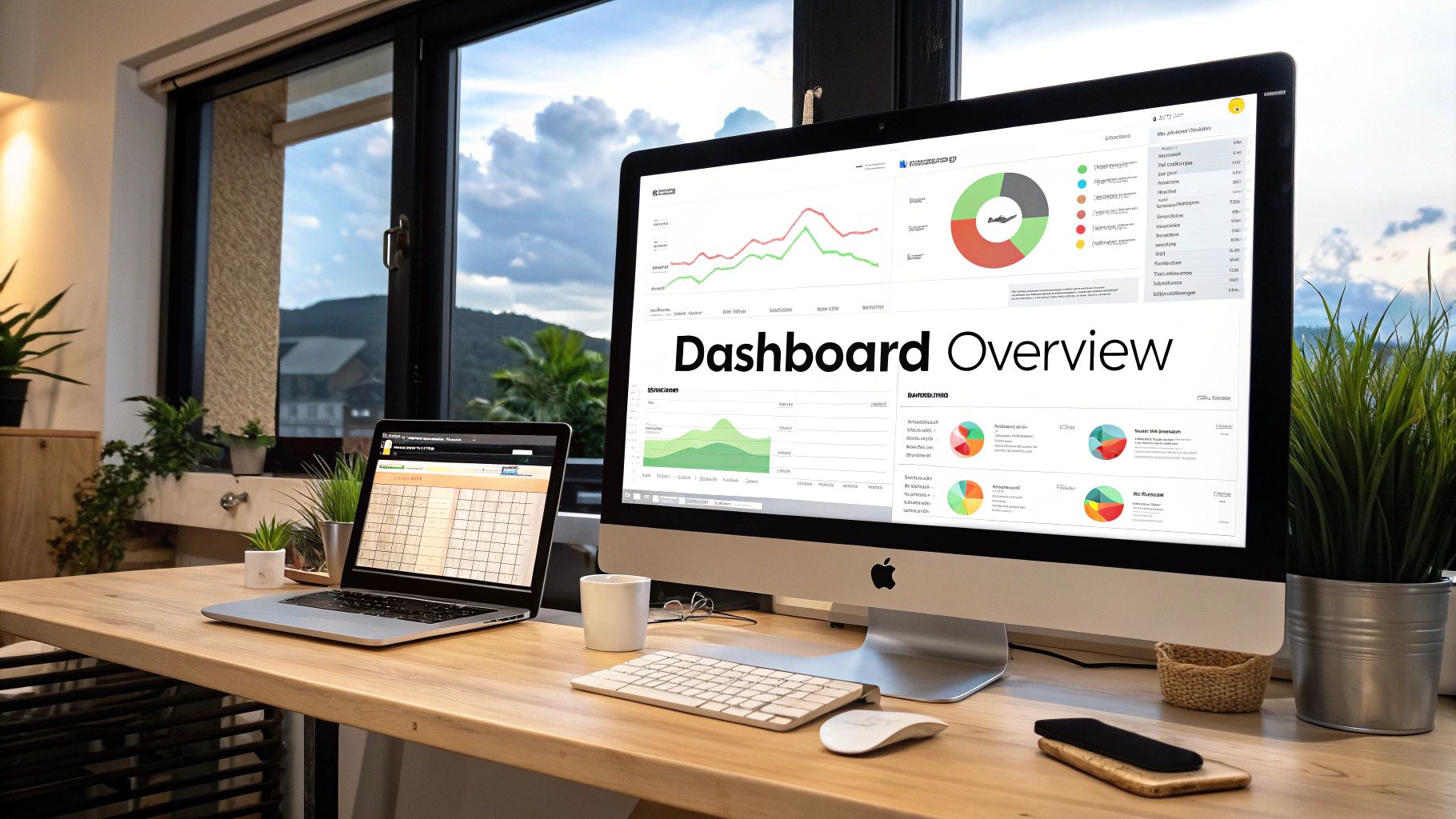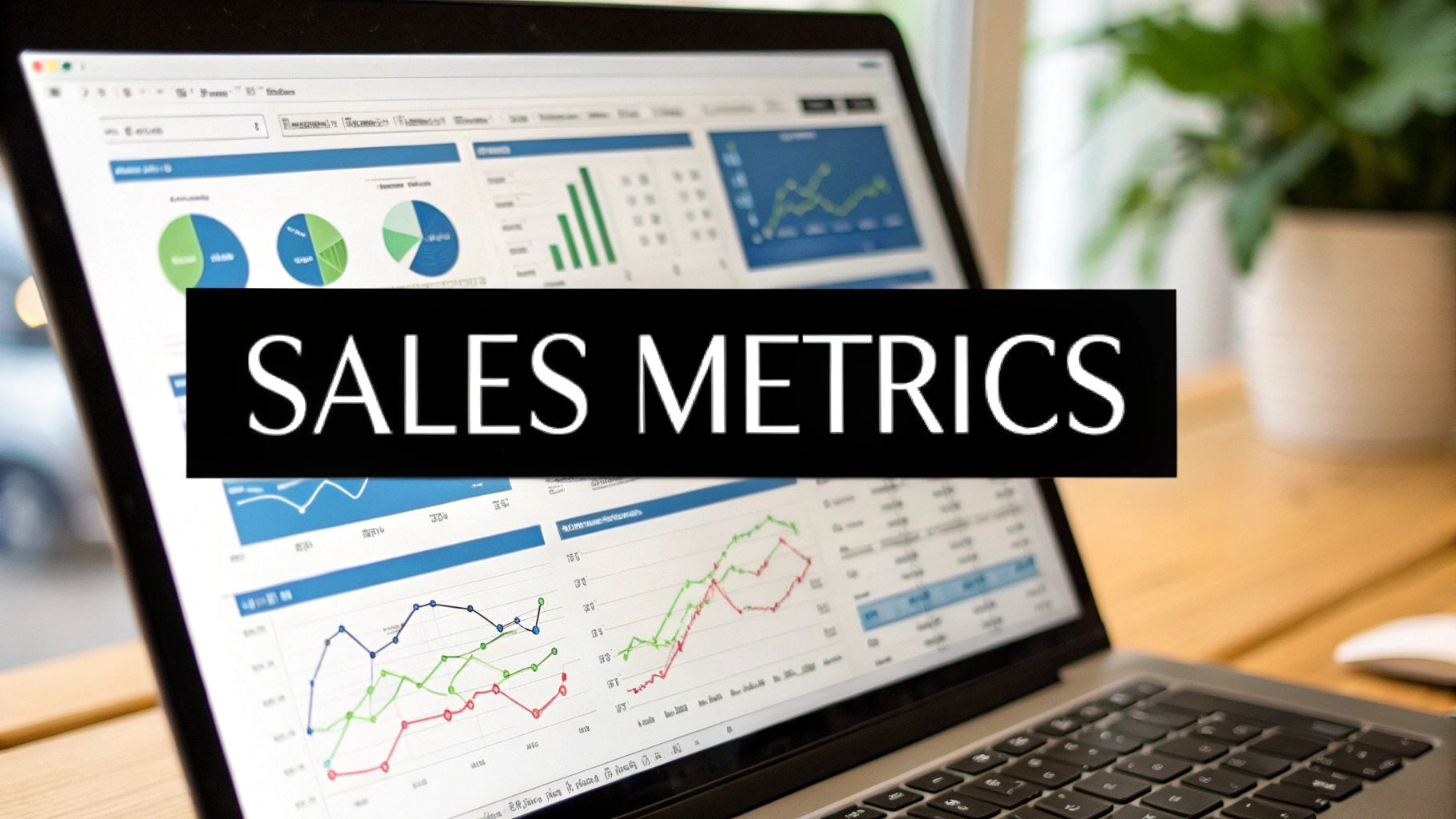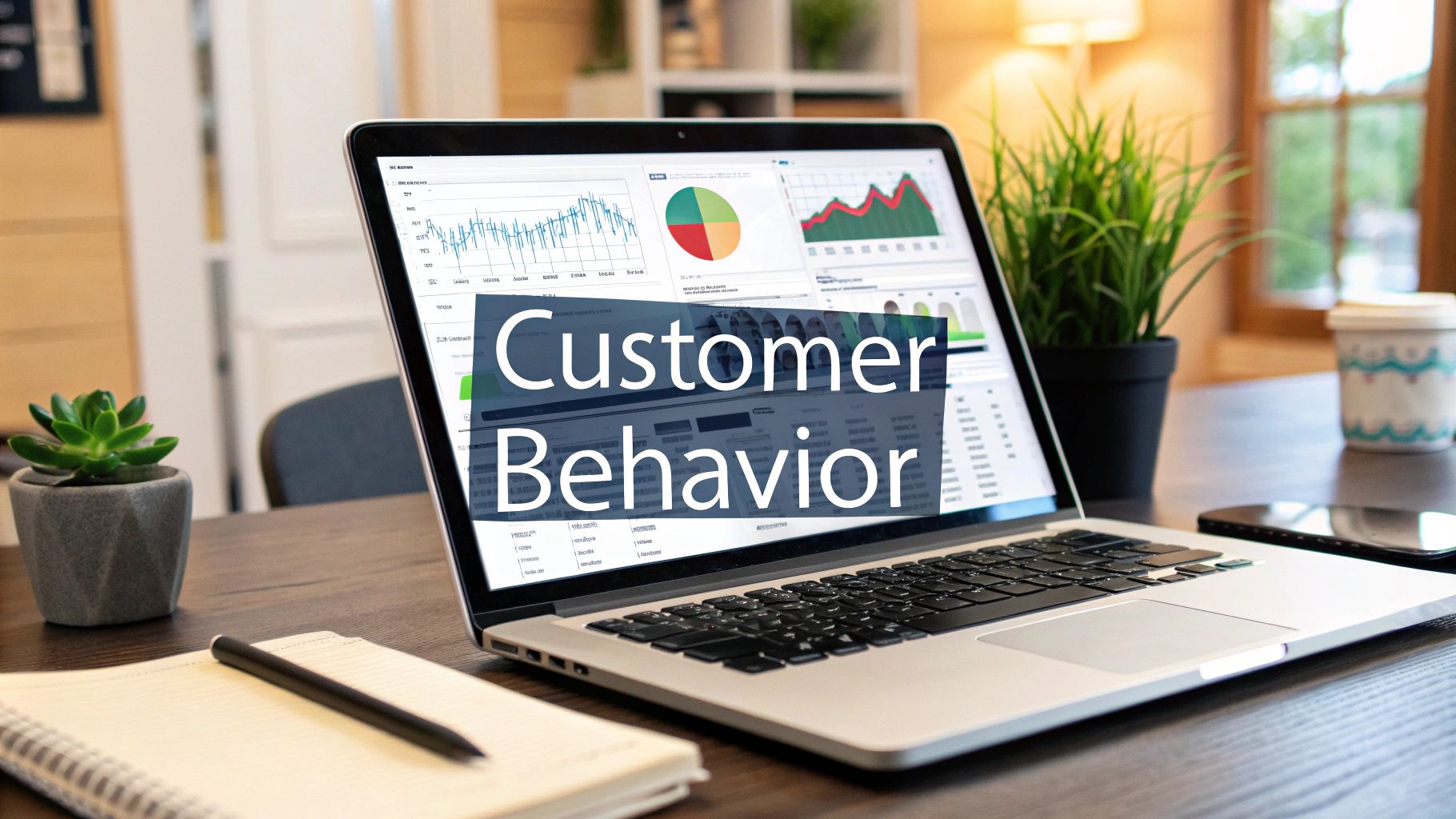Building Your Ecommerce Dashboard Foundation
An effective ecommerce dashboard is the nerve center of your online business. It transforms raw data into actionable insights, driving smart decisions and boosting growth. What sets a high-performing dashboard apart? It's built to inspire action, not just endless analysis.
Key Components of a Powerful Ecommerce Dashboard
A well-structured ecommerce dashboard needs several key components working together. This gives you a complete view while keeping the interface user-friendly and action-oriented. To get a better idea of these core dashboard elements, take a look at the table below. It breaks down the primary functions and business impacts of each essential component.
To illustrate the purpose of these components, let's dive into a table showcasing essential ecommerce dashboard components. This table gives a clear overview of core dashboard elements every ecommerce business should implement.
| Dashboard Component | Primary Function | Business Impact |
|---|---|---|
| Sales Metrics | Tracks revenue, orders, average order value, and conversion rates. | Provides a snapshot of sales performance and pinpoints areas for improvement. |
| Customer Behavior | Monitors customer journeys, buying habits, and demographics. | Helps personalize marketing and enhance customer experience. |
| Inventory Insights | Tracks stock levels, product performance, and supply chain efficiency. | Prevents stockouts, optimizes inventory management, and maximizes profits. |
| Marketing Performance | Analyzes campaign effectiveness, ROI, and customer acquisition costs. | Enables data-driven marketing decisions for maximum ROI. |
This integration is vital for a holistic business view. Linking sales data with customer behavior reveals which marketing campaigns are driving conversions. Combining inventory insights with sales trends allows for proactive stock management, avoiding stockouts and maximizing profitability.
Actionable Insights, Not Just Data

A powerful ecommerce dashboard translates complex data into workable strategies. This goes beyond pretty charts and graphs. It requires thoughtful data visualization that highlights key trends and encourages immediate action. Think of your dashboard as a business GPS, guiding you towards your objectives with clear directions and real-time feedback.
The UK ecommerce market offers a compelling example. It's one of the world's most advanced, with a substantial portion of retail sales occurring online. By 2025, the UK is projected to have 62.1 million ecommerce users, up from about 60 million in 2023. With online spending per shopper averaging $4,679, a robust ecommerce dashboard is essential. Learn more about UK ecommerce trends.
This rapid growth in the UK makes a strong ecommerce dashboard even more critical. Track key metrics like online spending per shopper, the influence of platforms like Amazon and Shopify, and overall ecommerce revenue. Building a solid foundation for your ecommerce dashboard is investing in your business’s future. It allows you to navigate shifting market dynamics and achieve sustainable growth.
Performance Metrics That Actually Drive Growth

Moving beyond superficial metrics like social media followers, let's explore the Key Performance Indicators (KPIs) that genuinely propel ecommerce success. These are the metrics that high-performing online retailers prioritize within their ecommerce dashboards, concentrating on sustainable growth and actionable insights.
Essential KPIs for Your Ecommerce Dashboard
A well-structured ecommerce dashboard should provide a comprehensive overview of your business performance by tracking a range of vital KPIs. These metrics shouldn't just be collected; they should actively inform your business decisions. Think of your dashboard as the control panel for your online store, enabling real-time monitoring and strategy adjustments.
-
Conversion Rate: This crucial metric measures the percentage of website visitors who complete a purchase. A higher conversion rate generally indicates a healthy and effective sales funnel.
-
Average Order Value (AOV): AOV represents the average amount spent per order. Increasing AOV can significantly impact revenue growth, making it a key metric to monitor.
-
Customer Lifetime Value (CLTV): CLTV predicts the total revenue a customer will generate throughout their relationship with your brand. Understanding CLTV helps optimize investment in customer acquisition and retention strategies.
-
Cart Abandonment Rate: This metric tracks the percentage of shoppers who add items to their cart but don't complete the purchase. A high abandonment rate can highlight friction points in your checkout process that need attention.
Interpreting Metric Relationships
Analyzing the relationships between different KPIs can reveal valuable insights. For example, a low conversion rate combined with a high cart abandonment rate might indicate problems with your checkout process. Perhaps shipping costs are prohibitive, or the available payment options are too limited.
Conversely, a rising AOV alongside a growing CLTV suggests successful upselling or cross-selling strategies. This indicates that customers are not only buying more per order but are also more likely to become repeat customers, demonstrating brand loyalty.
To help illustrate these relationships and their importance for varying business objectives, consider the following table:
Critical Ecommerce KPIs by Business Objective
Breakdown of which metrics matter most for different business goals
| Business Objective | Primary KPIs | Supporting Metrics | Ideal Reporting Frequency |
|---|---|---|---|
| Increase Sales Revenue | Conversion Rate, AOV | Cart Abandonment Rate, Website Traffic | Daily/Weekly |
| Improve Customer Retention | CLTV, Repeat Purchase Rate | Customer Churn Rate, Customer Satisfaction Score | Monthly/Quarterly |
| Optimize Marketing ROI | Cost per Acquisition (CPA), Return on Ad Spend (ROAS) | Conversion Rate, AOV | Weekly/Monthly |
| Enhance Website Performance | Bounce Rate, Page Load Time | Conversion Rate, Cart Abandonment Rate | Daily/Weekly |
This table demonstrates how focusing on specific KPIs, alongside supporting metrics, can help achieve different business objectives. Regularly reporting on these metrics provides valuable insights to track progress and make necessary adjustments.
Benchmarking for Success
Establishing relevant benchmarks is crucial for tracking progress and setting achievable goals. Benchmarking allows you to compare your performance against industry averages and pinpoint areas for improvement. Remember, benchmarks should be tailored to your specific business model. A small startup will have different benchmarks than a large, established corporation.
Consider the growth of ecommerce in the UK. In 2023, ecommerce sales saw a 4.8% increase, with projections suggesting continued growth of 3.8% by 2028. The online share of retail sales is expected to reach 38.1% by 2025. An effective ecommerce dashboard for UK businesses should track these trends, along with online spending per shopper. Find more detailed statistics here.
This data provides valuable context for setting benchmarks and adapting strategies to the evolving market. By using an ecommerce dashboard like Mergoio, businesses can transform this data into actionable insights, optimizing pricing strategies and maximizing profitability.
Securing Your Ecommerce Dashboard Against Threats

Security is paramount for any ecommerce business. It's not simply about protecting data; it's about safeguarding customer trust and your brand's reputation. Your ecommerce dashboard should be a fortress, incorporating key security features to defend against evolving threats. This goes beyond strong passwords and requires a proactive, data-driven approach.
Real-Time Fraud Detection
Integrating real-time fraud detection into your ecommerce dashboard is like having a vigilant security guard constantly on the lookout for suspicious activity. Visualizations of transaction data can highlight unusual patterns. These might include sudden spikes in orders from a single IP address or multiple purchases with different credit cards shipped to the same location. This allows for quick responses, potentially preventing fraudulent transactions before they impact your profits.
For example, imagine a sudden influx of orders from a country where you don't typically conduct business. This anomaly, easily spotted on your dashboard, could trigger an immediate investigation, preventing potential losses from fraudulent activities. Early detection and swift action are key to minimizing the damage from such attacks.
Ecommerce fraud is a serious and growing problem. In 2022, global losses due to ecommerce fraud reached approximately $41 billion, and this number is expected to rise. Implementing robust security measures is no longer optional; it's a business necessity. Find more detailed statistics here.
Payment Security Monitoring
Monitoring payment security metrics is crucial for any online business. Your ecommerce dashboard should track key indicators. These include declined transactions, chargebacks, and any suspicious payment activity. These metrics, when visualized effectively, can reveal vulnerabilities in your payment processing system. This allows you to proactively address weaknesses and prevent future security breaches.
Regularly checking these metrics also helps ensure compliance with industry regulations like the PCI DSS (Payment Card Industry Data Security Standard). Maintaining compliance is not only important for avoiding penalties, but also for building customer trust and confidence in your brand's security practices.
Compliance and Security Protocols
Staying ahead of evolving security threats requires constant vigilance and adaptation. Your ecommerce dashboard should facilitate regular security audits and compliance checks. This includes tools for tracking software updates, managing user permissions, and monitoring access logs. Think of it as a central control panel for all your security operations.
Your dashboard should also support the development and implementation of robust security protocols. This means establishing clear procedures for responding to security alerts, training employees on best security practices, and regularly reviewing and updating security policies. These proactive measures create a layered security approach, making your ecommerce business a less appealing target for cybercriminals. A secure dashboard, such as the one offered by Mergoio, helps protect your business and build a strong reputation for security and trust with your customers.
Creating Role-Specific Ecommerce Dashboard Views

One-size-fits-all ecommerce dashboards often miss the mark. Different team members have different data needs. Executives need a high-level overview, while marketing teams thrive on granular campaign data. This section explores how to create targeted dashboard views within your ecommerce dashboard that cater to specific roles, maximizing its value across your organization.
Executive Overview Dashboards
Executives require a concise snapshot of overall business performance. Their ecommerce dashboards should focus on key metrics like total revenue, profit margins, and year-over-year growth. For example, a CEO might want to see a quick overview of sales performance across different product categories or regions.
This allows them to quickly identify areas of strength and weakness, informing strategic decisions. These dashboards should prioritize clear, easily digestible visualizations, such as summary charts and graphs. This avoids overwhelming executives with excessive detail and allows for quick, data-informed decision-making. The goal is to provide a clear picture of overall business health at a glance.
Marketing Team Dashboards
For marketing teams, the focus shifts to campaign performance and customer acquisition. Their ecommerce dashboard views should highlight metrics such as conversion rates, cost per acquisition, and return on ad spend (ROAS). Additionally, tracking website traffic, bounce rates, and customer engagement metrics provides valuable insight into campaign effectiveness.
This data allows marketers to fine-tune campaigns, optimize ad spend, and improve overall marketing ROI. For example, a low conversion rate coupled with high website traffic might indicate a problem with the user experience or checkout process, prompting targeted improvements.
Inventory Management Dashboards
Effective inventory management is crucial for avoiding stockouts and maximizing profitability. Inventory-focused ecommerce dashboards should provide real-time visibility into stock levels, product performance, and supply chain efficiency. Tracking key metrics like sell-through rates, inventory turnover, and days sales of inventory helps anticipate demand and optimize purchasing decisions.
For example, a sudden drop in stock levels for a popular product, easily visible on the dashboard, would trigger an immediate reordering process, preventing lost sales due to stockouts. This proactive approach helps maintain optimal inventory levels and ensures a smooth customer experience.
Customer Service Dashboards
Customer service teams rely on data to understand customer issues and improve response times. Their ecommerce dashboards should track metrics like customer satisfaction scores, resolution times, and common support inquiries. Visualizing this data can reveal patterns in customer feedback and identify areas for service improvement.
For instance, a high volume of complaints about a specific product could indicate a quality control issue that needs immediate attention. A tool like Mergoio can help create these tailored dashboards, streamlining this process for optimal insights and action. This data-driven approach empowers customer service teams to proactively address customer concerns and enhance overall satisfaction.
Connecting Your Ecommerce Dashboard Ecosystem
The most powerful ecommerce dashboards serve as central command centers, connecting and sharing vital data across your entire business infrastructure. This interconnectedness elevates your dashboard from a simple reporting tool to a dynamic engine for growth. This section explores the critical integration strategies that link your dashboard with other essential platforms, such as inventory management systems, CRM software, marketing tools, and payment processors.
Essential Integrations for a Unified View
Integrating your ecommerce dashboard with key platforms creates a single, unified view of your business operations. This eliminates data silos and provides a comprehensive understanding of how different parts of your business interact and influence each other.
-
Inventory Management System Integration: Connecting your dashboard to your inventory management system allows real-time tracking of stock levels. This helps prevent stockouts, optimize fulfillment processes, and ensure accurate product availability is displayed on your website.
-
CRM Integration: Linking your CRM to your dashboard provides valuable customer insights. This data enables targeted and personalized marketing campaigns, improves customer segmentation for more effective outreach, and strengthens customer relationship management overall.
-
Marketing Tool Integration: Integrating your marketing tools with your dashboard directly connects campaign performance to sales data. This allows you to accurately measure the effectiveness of your various marketing initiatives, optimize ad spend based on real results, and improve overall marketing ROI.
-
Payment Processor Integration: Connecting your payment processor to your dashboard gives you real-time transaction data. This facilitates fraud detection, streamlines reconciliation processes for easier accounting, and enables accurate revenue tracking for a clearer financial picture.
Technical Requirements and Common Challenges
While the benefits of integration are clear, successful implementation requires careful planning and execution. Understanding the technical requirements and potential challenges can help you proactively address potential roadblocks.
One common challenge is ensuring data consistency across different platforms. Different systems may use varying data formats or naming conventions. This can create discrepancies and inaccuracies if not addressed properly during the integration process.
Another challenge involves maintaining real-time synchronization. Data needs to flow seamlessly between systems to ensure your dashboard always displays the most current information.
For example, if your inventory management system registers a sale, but that information isn't immediately updated on your dashboard, it could lead to inaccurate sales figures and the potential for overselling a product that is actually out of stock.
Solutions and Best Practices
Several solutions and best practices can help you overcome integration challenges and ensure smooth and efficient data flow.
-
API Utilization: Application Programming Interfaces (APIs) provide a standardized way for different systems to communicate. Using APIs is essential for seamless data exchange between your platforms.
-
Middleware Options: Middleware serves as a bridge between different systems, translating data and ensuring compatibility. Implementing middleware can simplify the integration process and improve data consistency.
-
Integration Maintenance Protocols: Establishing clear protocols for maintaining and updating integrations is critical for long-term success. This ensures your systems continue to function smoothly and efficiently as your business grows and evolves.
Platforms like Mergoio offer robust integration capabilities, connecting your ecommerce dashboard with key systems. This provides the unified perspective necessary for data-driven decision-making. This level of integration allows you to optimize operations, create better customer experiences, and ultimately, drive significant business growth. Connecting your ecommerce ecosystem transforms your dashboard into a powerful resource for informed decision-making and sustainable growth.
Mobilizing Your Ecommerce Dashboard Strategy
Making informed business decisions isn't limited to the office. This makes having a mobile-optimized ecommerce dashboard essential for success in today's competitive online retail world. Forward-thinking retailers recognize this and have implemented responsive dashboards that maintain full functionality across devices without compromising security.
Designing for Smaller Screens
Building a mobile-first ecommerce dashboard starts with presenting data clearly and concisely. Prioritize key metrics for smaller screens. For instance, prominently displaying total sales, conversion rate, and average order value allows for quick performance checks. Less critical information can be tucked away in expandable menus or secondary screens.
This ensures the most important data is easily accessible, even on smaller screens, enabling swift decision-making on the go. Just as pilots need essential instruments readily visible, you need your core ecommerce metrics at your fingertips, no matter where you are.
Prioritizing Features on Mobile
Not every feature from your desktop dashboard needs to be on mobile. Focus on the features that support time-sensitive decisions and actions. For example, push notifications for significant sales drops or unexpected traffic spikes enable immediate action, even when away from your computer.
Mobile dashboards should also facilitate quick responses to urgent customer service inquiries or operational issues. Think of it as having a streamlined command center available at all times.
Implementing a Smart Notification Framework
Mobile notifications are a powerful tool, but too many can become overwhelming. A well-designed notification system for your ecommerce dashboard should deliver only essential alerts, preventing notification fatigue. This is often accomplished with customizable alert thresholds. For example, you might opt to receive notifications only for sales drops exceeding a certain percentage or when a specific product is out of stock.
Consider segmenting notifications by team or role. This ensures each team member receives only relevant alerts, promoting efficiency and minimizing distractions.
Capitalizing on Mobile Opportunities
Mobile dashboards empower you to react quickly to emerging challenges and seize opportunities. Imagine noticing a sudden traffic surge from a specific marketing campaign while you're out. With a mobile dashboard, you can immediately adjust your ad spend to maximize the increased interest.
This agility can be the difference between a successful campaign and a missed opportunity. By enabling real-time monitoring and action, mobile dashboards give you a competitive edge in today's dynamic ecommerce environment. Experience the power of mobile with a robust platform like Mergoio, designed for ecommerce success. Visit Mergoio to learn more and transform your business.
Article created using Outrank

Leave a Reply